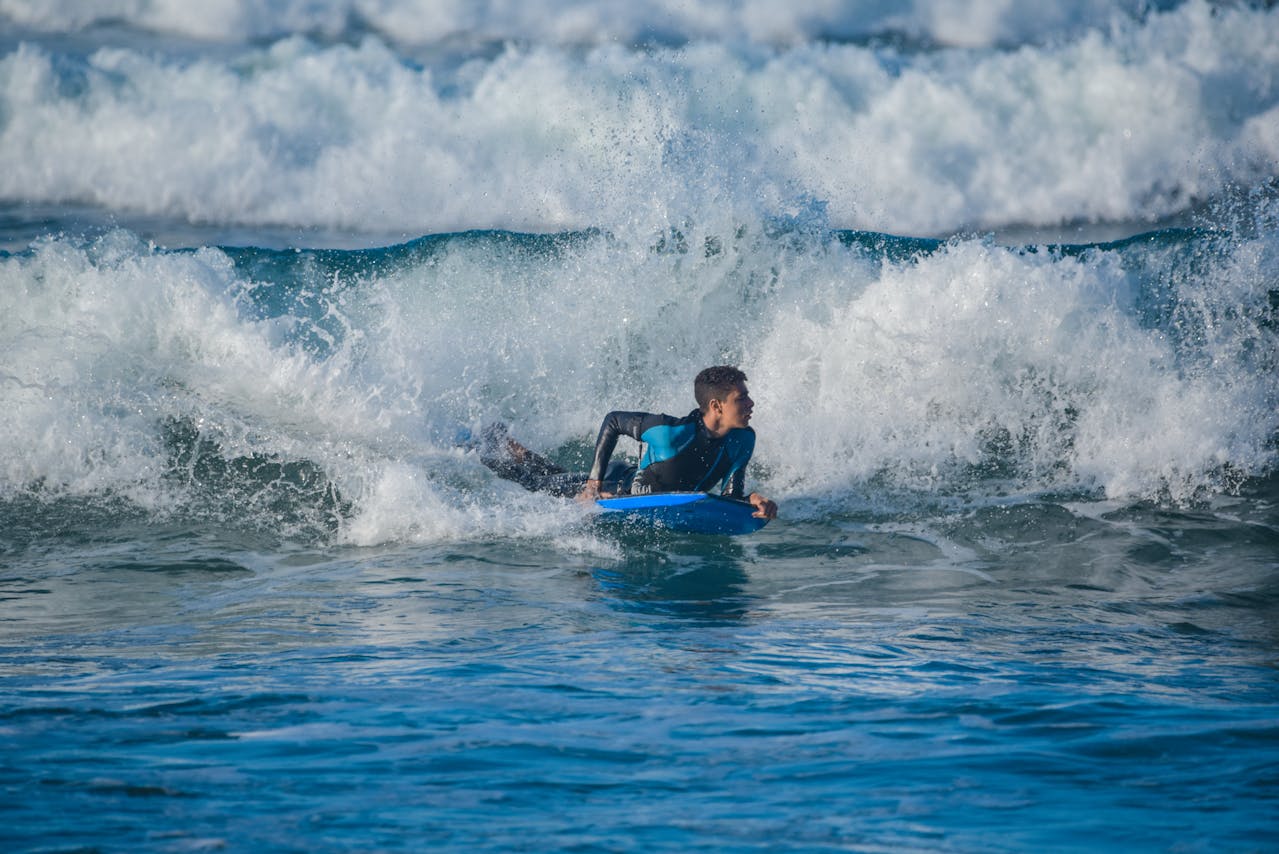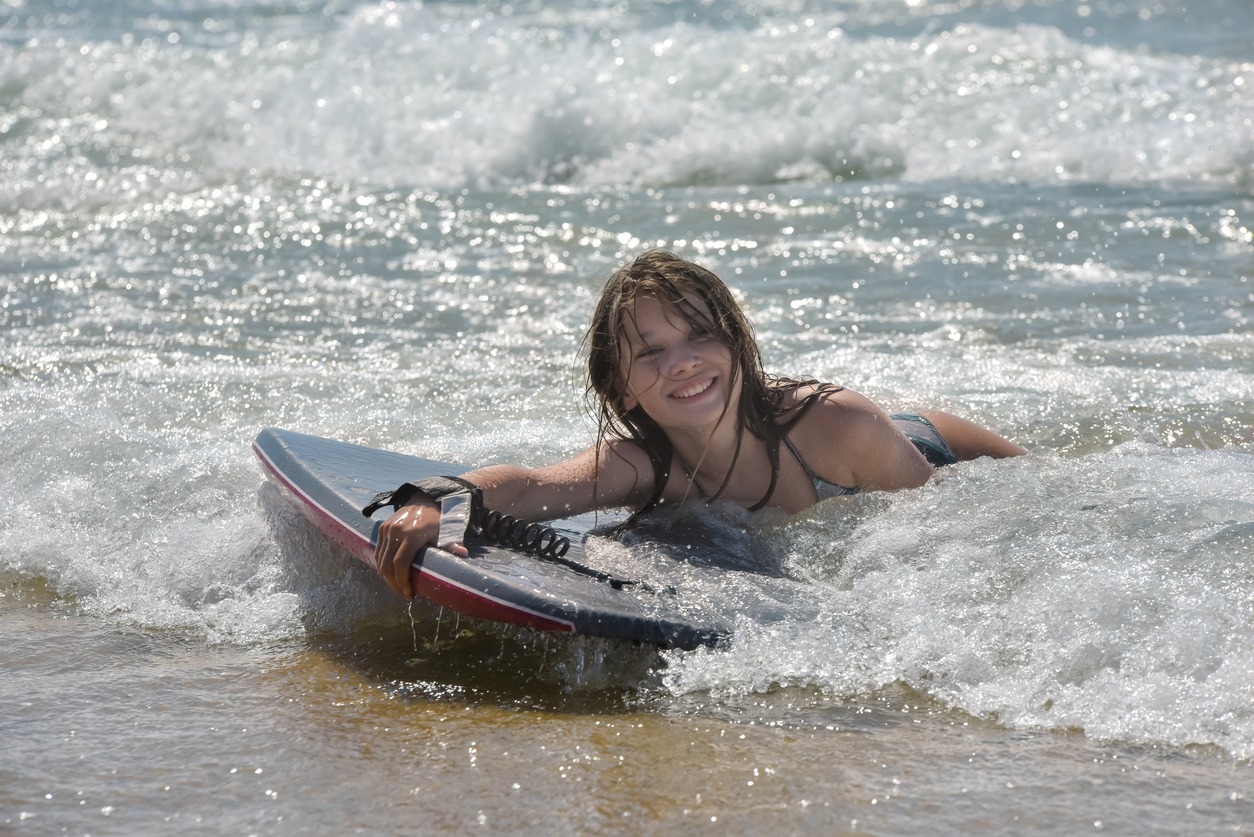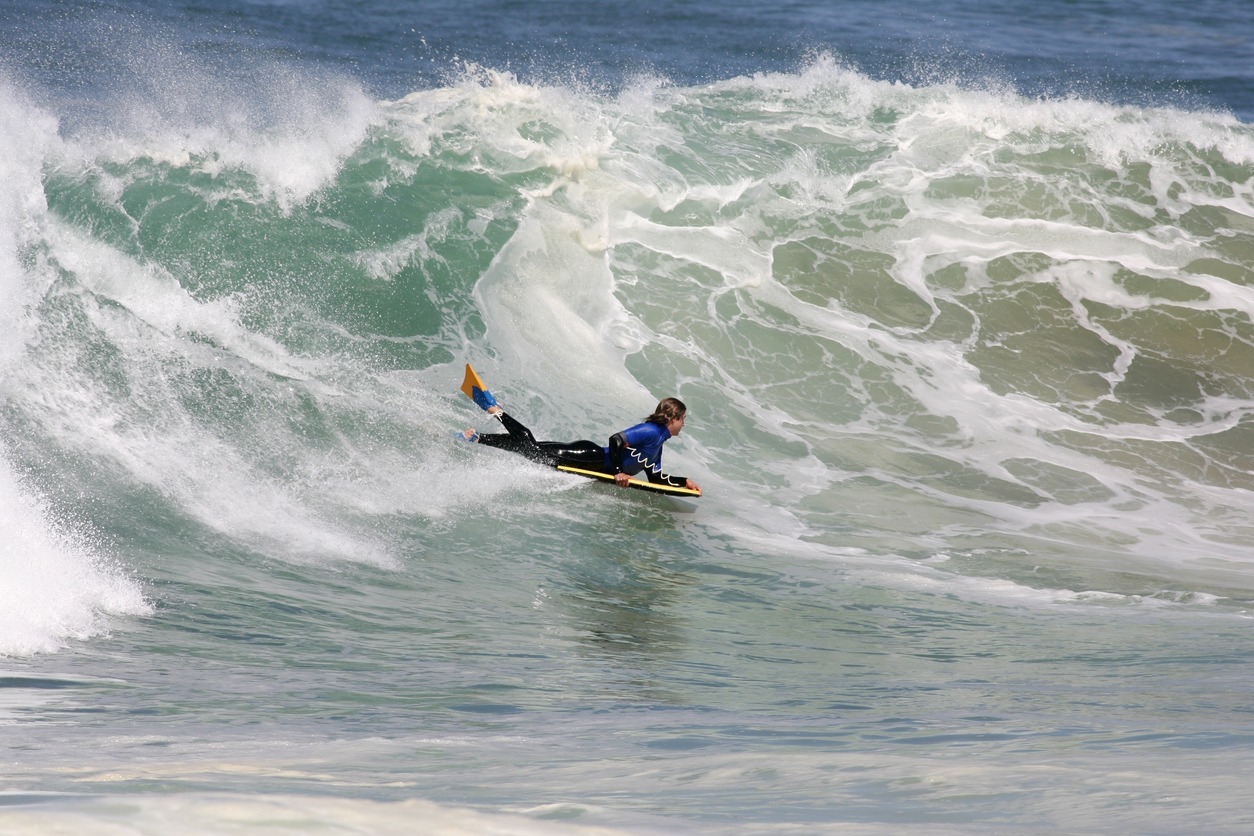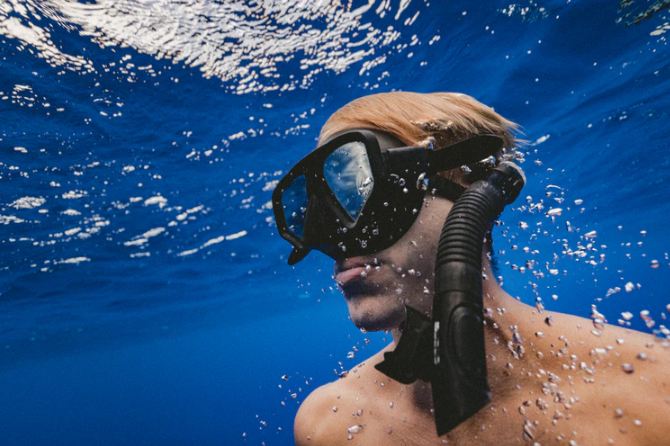Protecting Yourself While Bodyboarding: Safety Tips for Beginners
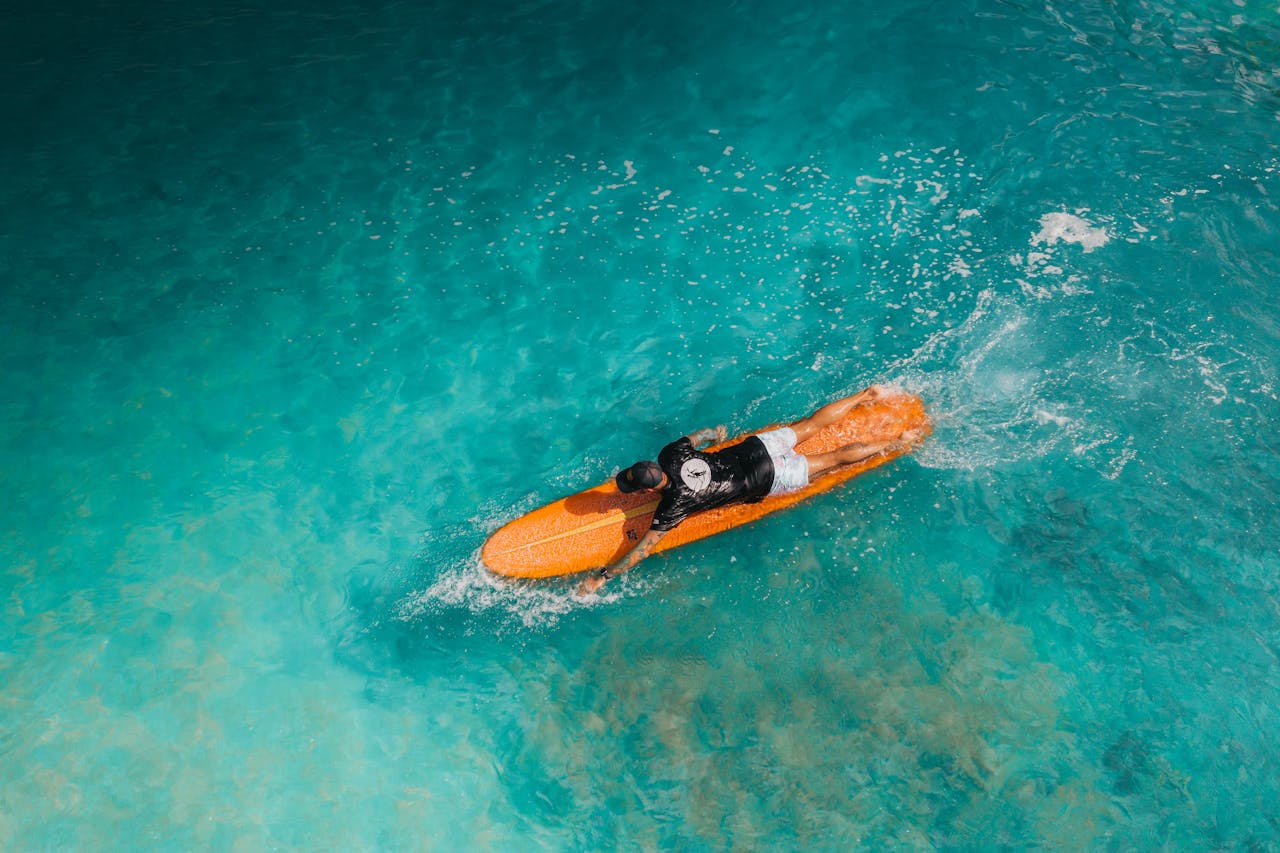
To protect yourself while bodyboarding, start by choosing the right equipment for your skill level. Understand ocean conditions and always check surf reports before heading out. Conquer proper techniques to maintain control and stability on your board. Stay aware of your surroundings, including potential hazards like rip currents or submerged rocks. Prepare physically with cardio and strength training to improve endurance and control. Recognize your limitations and progress gradually. Always bodyboard with a buddy and establish clear communication. Don't forget sun protection and basic emergency response knowledge. These tips will help keep you safe, but there's much more to learn about bodyboarding safety.
Choosing the Right Equipment
Selecting the right bodyboard is essential for a safe and enjoyable experience. As a beginner, you'll want to opt for a board that reaches from your knees to your chin when standing. This size provides ideal stability and control, allowing you to navigate waves more confidently. Choose a soft foam board, which offers buoyancy and forgiveness, making it easier to learn and reducing the risk of injury.
As you progress, you may consider high-density foam or polyethylene boards for increased speed and maneuverability. However, always guarantee the board size aligns with your height and skill level to maintain proper fit and performance. When selecting your board, consider the stringer configuration as well. Polyethylene and polypropylene offer different riding experiences and are suitable for various water temperatures.
Understanding Ocean Conditions
Now that you've got the right equipment, it's time to focus on the ocean itself. Understanding ocean conditions is essential for your safety while bodyboarding. First, be aware of rip currents, which can quickly pull you away from shore. Recognizing rip currents by their visual cues can help you learn to identify and escape them to avoid dangerous situations.
Pay close attention to wave size, wind direction, and tidal conditions, as these factors greatly impact your safety and the difficulty of your ride. Always check local surf reports and heed any warnings about dangerous or high surf conditions before entering the water. Choosing a lifeguarded beach can also help guarantee your safety.
Be cautious of shore-breaking waves, which can slam you into the sand and cause serious injuries. Avoid these areas whenever possible. Additionally, be mindful of shallow water near shore breaks or in beach coves, as impacts with the bottom can lead to severe injuries.
Mastering Proper Bodyboarding Techniques
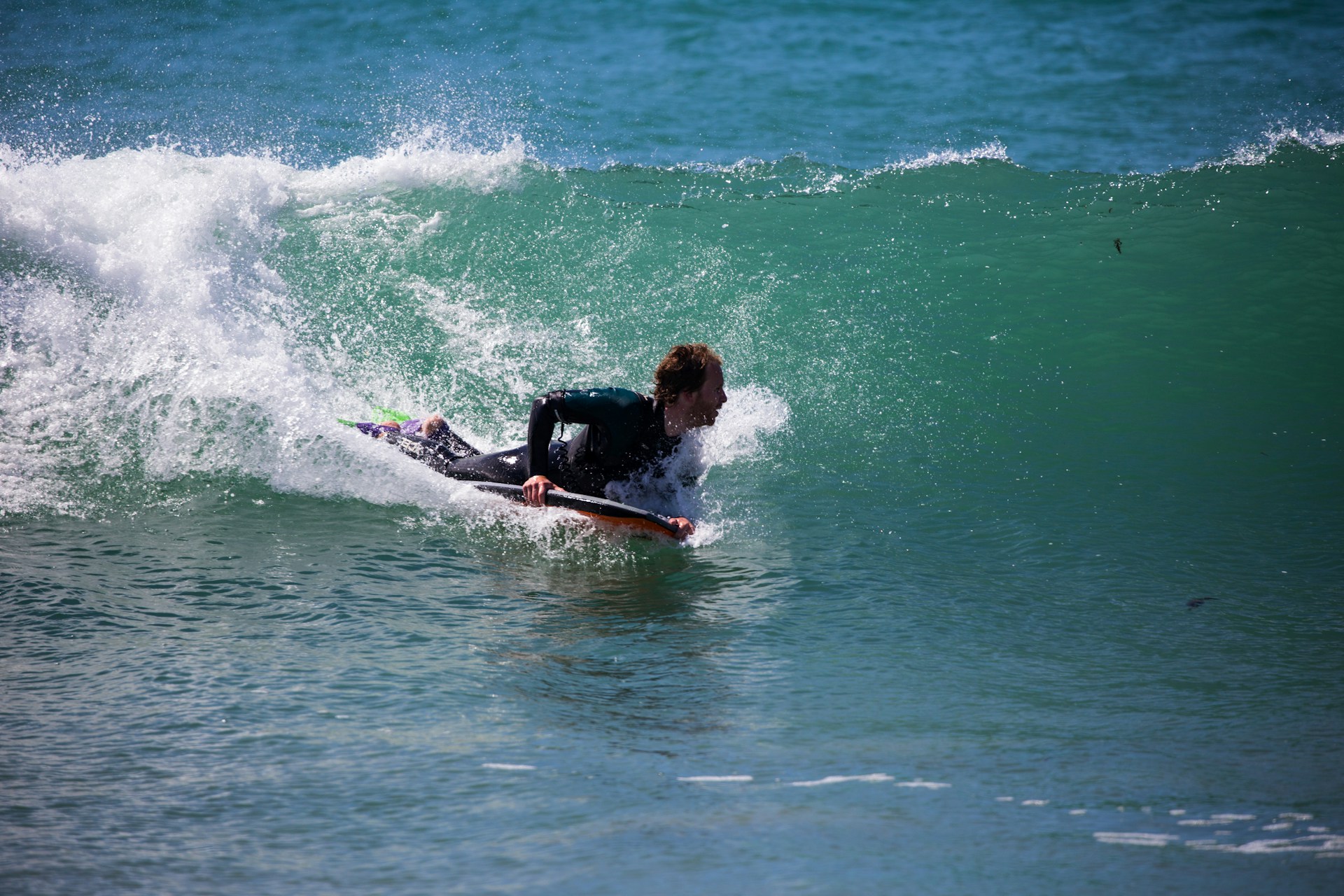
Proper technique is the foundation of safe and enjoyable bodyboarding. When you're ready to start riding waves, position yourself on your board with your chest at the front edge and your arms gripping the sides. Keep your legs straight behind you, using them to steer and control your speed.
As you paddle out, time your movements with the surf to conserve energy. When a suitable wave approaches, start paddling with strong, alternating arm strokes to match its speed. As the wave lifts you, push down on the front of your board with your arms to prevent nosediving.
Once you're on the wave, keep your body low and centered on the board for stability. Use your arms and legs to adjust your position and maintain control. To turn, lean your body in the desired direction while applying pressure with your opposite hip.
Remember these safety tips: Always bodyboard in areas suitable for your skill level, stay aware of your surroundings, and never turn your back on the ocean. With practice and these tips and tricks, you'll become an expert in proper bodyboarding techniques and enjoy a safer experience in the waves.
Staying Aware of Surroundings
While enjoying the thrill of bodyboarding, it's crucial to maintain constant awareness of your surroundings. As you prepare to catch your first wave, scan the water for potential hazards like rip currents, submerged obstacles, or unusual wave patterns. Keep your board parallel to the shore while evaluating the conditions, and always be mindful of other swimmers, surfers, and bodyboarders nearby to avoid collisions.
Familiarize yourself with the beach's terrain, including shallow areas and rocks that could cause injuries. Observe experienced bodyboarders to identify the best spots and learn which zones to avoid. This observation will help you develop a better understanding of water safety and improve your overall experience.
For added protection, stay within designated swimming and bodyboarding areas monitored by lifeguards. These zones are typically safer and offer quick assistance if needed. By remaining vigilant and aware of your environment, you'll be better equipped to handle unexpected situations and enjoy a safer bodyboarding experience. Remember, your safety depends on your ability to read the water, anticipate potential risks, and react accordingly.
Physical Preparation and Fitness
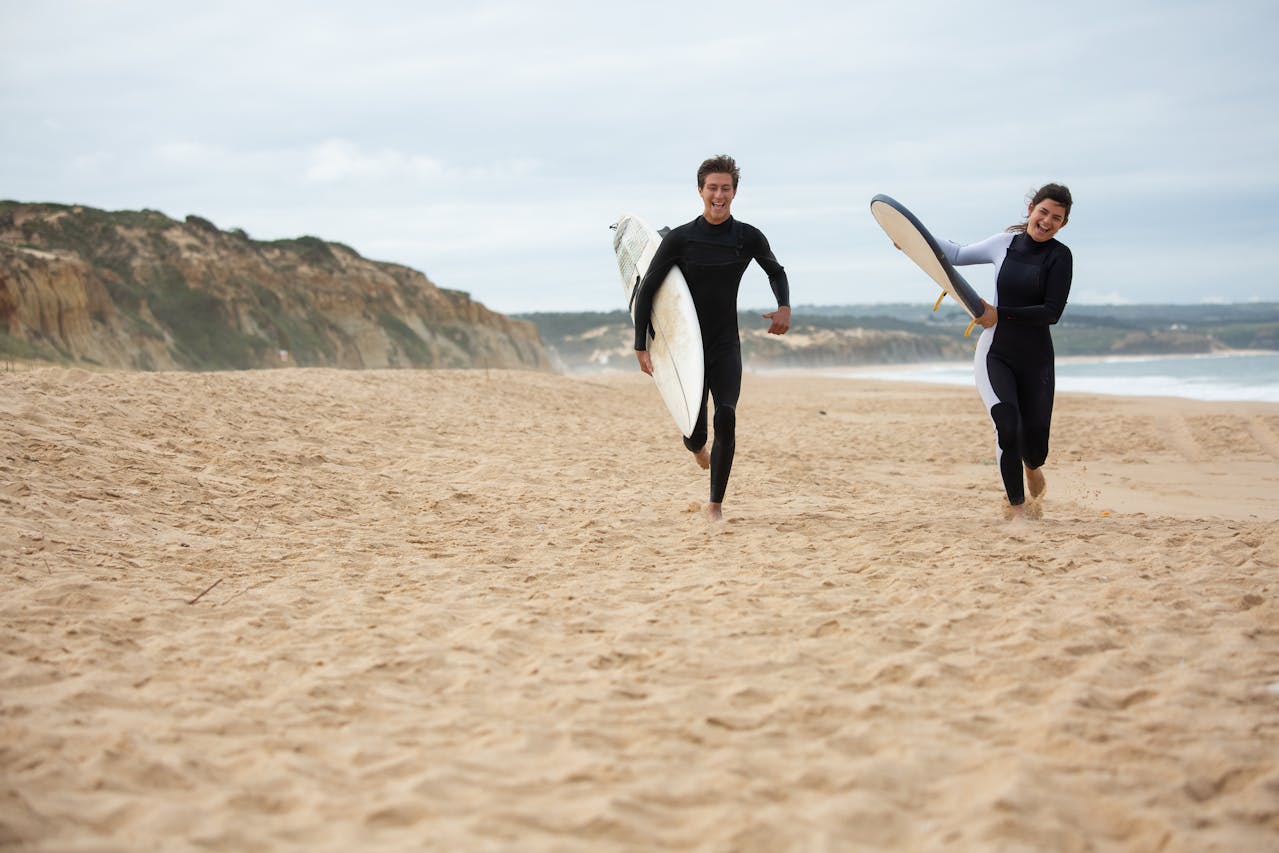
Physical fitness forms the foundation of a safe and enjoyable bodyboarding experience. To guarantee your safety and maximize your time in the water, it's vital to prepare your body for the demands of this exhilarating sport. By focusing on cardiovascular endurance, strength, and flexibility, you'll be better equipped to handle the challenges of bodyboarding.
First, incorporate regular cardio exercises like swimming and running into your routine. These activities will improve your endurance and help you feel more comfortable in the water. Next, strengthen your core, shoulders, and lower body muscles to enhance stability and control on the board. Don't forget to include stretching and mobility exercises to prevent injuries and improve your range of motion.
Implement a proper warm-up routine before entering the water
Maintain a consistent cool-down routine after each session
Stay hydrated before, during, and after bodyboarding
Follow a balanced diet to optimize energy levels and recovery
Gradually increase your time in the water to build stamina
Recognizing Personal Limitations
Recognizing your personal limitations is a key aspect of bodyboarding safety. As a beginner, it's imperative to start with smaller, less powerful waves that match your skill level and comfort zone. Don't be tempted to tackle larger waves before you're ready, as this can lead to losing control and increasing your risk of injury.
To confirm your safety, honestly assess your swimming ability and physical fitness. This self-awareness will help you determine which surf conditions are appropriate for you. Remember, it's not just about the size of the waves, but also the power of the break and your capability to maneuver it safely.
As you gain experience and improve your skills, you can gradually progress to more challenging conditions. This approach allows you to build confidence and develop the necessary techniques to handle larger waves safely. By following these tips and recognizing your limitations, you'll have a more positive and enjoyable bodyboarding experience.
Always prioritize safety over pushing your limits too quickly. With patience and practice, you'll be able to tackle more demanding waves while minimizing risks.
Buddy System and Communication
Nearly every experienced bodyboarder will attest to the importance of the buddy system. When you're out catching waves, having a companion nearby can be a lifesaver in emergencies. Establish a clear communication plan with your bodyboarding partners to signal for help or alert others to dangerous conditions. Before hitting the surf, agree on a meeting point on the beach in case you get separated, and make a habit of checking in with each other periodically.
To guarantee everyone's safety, follow these key buddy system practices:
- Always bodyboard with a friend or group
- Inform your companions about your swimming ability and experience level
- Stay within visual range of your group
- Avoid straying too far from others, especially in unfamiliar spots
- Disclose any medical conditions to your buddies
Sun Protection Strategies
While keeping an eye on your buddies is critical, protecting yourself from the sun's harmful rays is equally important for a safe bodyboarding experience. The sun and potential damage it can cause shouldn't be underestimated, so take precautions before hitting the waves.
Your First Step should be to don a rash guard or lightweight, breathable long-sleeve shirt. This essential piece of gear protects your skin from harmful UV rays while you're riding the waves. Next, apply a waterproof, reef-safe sunscreen with an SPF of at least 30 to all exposed skin. Remember to reapply every two hours, or more often if you're swimming or sweating excessively.
Don't forget to cover your head with a wide-brimmed hat or baseball cap to shield your face and neck from direct sun exposure. When you're taking breaks from the water, seek shade under a beach umbrella or canopy. This will help prevent sunburn and give your skin a much-needed respite from the intense sun.
Emergency Response Knowledge
Armed with sun protection knowledge, it's essential to equip yourself with emergency response skills before hitting the waves. Understanding how to handle potential dangers can make the difference between a fun day at the beach and a life-threatening situation.
- Learn to identify rip currents
- Familiarize yourself with local emergency procedures
- Know how to signal for help
- Take a water safety course
- Keep a charged phone nearby
Start by learning how to spot and escape rip currents, which can quickly pull you away from shore, especially during low tide. Familiarize yourself with the location of lifeguard stations and emergency procedures specific to the beach you're visiting. It's imperative to understand how to signal distress, whether by waving an arm or calling out for help when you feel the wave pulling you out.
Consider taking a water safety course to master techniques for floating, treading water, and self-rescue. These skills are priceless when waves that break unexpectedly catch you off guard. Finally, always keep a charged mobile phone with you to call for help if needed. By preparing for emergencies, you'll be better equipped to handle any situation that arises while bodyboarding.

